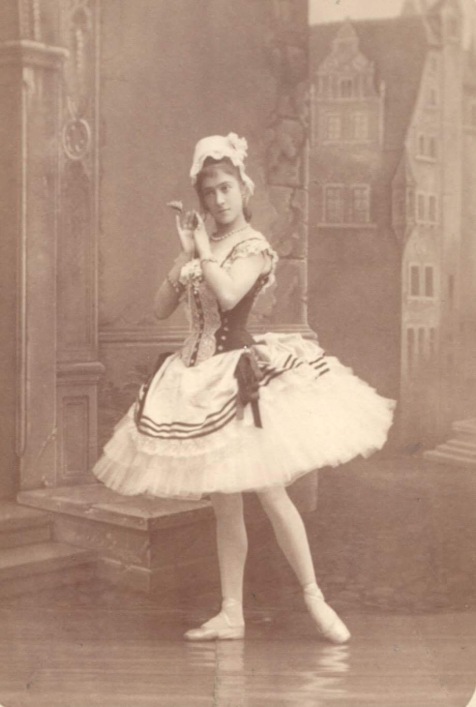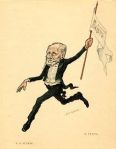Ballet comique in three acts
Music by Léo Delibes
Libretto by Charles Nuitter and Arthur Saint-Léon
World Première
25th May 1870
Théâtre Impérial l’Opéra, Paris
Choreography by Arthur Saint-Léon
Original 1870 Cast
Swanhilda
Giuseppina Bozzacchi
Franz
Eugénie Fiocre
Moscow Première
5th February [O.S. 24th January] 1882
Imperial Bolshoi Theatre
Choreography by Joseph Hansen
St Petersburg Première
7th December [O.S. 25th November] 1884
Imperial Bolshoi Kamenny Theatre
Choreography by Marius Petipa
Original 1884 Cast
Swanhilda
Varvara Nikitina
Franz
Pavel Gerdt
Dr Coppélius
Timofei Stukolkin
Première of Petipa’s final revival
8th February [O.S. 26th January] 1894
Imperial Mariinsky Theatre
Original 1894 Cast
Swanhilda
Pierina Legnani
Plot
Set in an Austrian village, the doll maker, Dr. Coppélius has made a beautiful mechanical doll that he has named Coppélia and she sits on his balcony reading her book. However, she is so realistic that everyone mistakes her for a young girl, possibly Dr. Coppélius’s daughter, and the young Franz even falls in love with her, much to the annoyance of his fiancée, Swanhilda. Determined to discover the secret behind the mysterious Coppélia, Swanhilda and her friend sneak into Dr Coppélius’s house, only to discover that her rival is nothing more than a mechanical doll. When Dr. Coppélius returns, the girls flee, but Swanhilda hides with Coppélia and disguises herself as the doll. At the same time, Franz sneaks into meet Coppélia, but Dr. Coppélius catches him and puts him to sleep so he can use him as a human sacrifice to bring his beloved doll to life. He believes he has succeeded when Coppélia seemingly springs to life, but it is actually Swanhilda dressed up as the doll. When Franz wakes up, Dr. Coppélius realises he has been tricked and that Coppélia is nothing more than a doll. Swanhilda forgives Franz for his folly and the two are married in a feast to celebrate the new church bell.

History
Coppélia was the creation of Arthur Saint-Léon and his two collabators for the Paris Opéra, the composer Léo Delibes and the wealthy theatre-lover Charles Nuitter, who had undertaken the task of organising the Opéra’s archives. The three men had previously created Saint-Léon’s 1866 ballet La Source and when the time to create a new ballet came, they decided on a comedy based on the two stories The Sandman and The Doll by E.T.A. Hoffmann. The ballet produced was entitled Coppélia and would go onto become the most frequently performed ballet in the history of the Paris Opéra. For the leading role of Swanhilda, Saint-Léon initially had Adèle Grantzow in mind to create the role, but she fell ill in the summer of 1868 and a desperate search mounted for another ballerina. The search was so desperate that Delibes was sent to the ballet schools in Italy to search for the ballerina they needed and during his absence, that ballerina was found in the 15 year old Giuseppina Bozzacchi, who was a student of Mme. Dominique at the School of Dance. However, the young Bozzacchi had never appeared in public and Saint-Léon had to radically re-choreograph and reshape the role that he had originally created for an experienced ballerina.
In accordance with the policies of the Paris Opéra at the time, the role of Franz was created as a travesty role i.e. performed by a woman in male garb. The policies at the time were that the ballerina was the ruler of the Paris Opéra stage, while the danseur had been pushed into her shadow and was reduced to performing purely mimed roles. The dance roles were reserved for the women, who would dance both the male and female roles, which resulted in many male roles being created as travesty roles for danseues en travesti. The role of Franz was originated by Eugénie Fiocre, the Opéra’s most celebrated danseuse en travesti. Nuitter wrote the libretto and Delibes composed what would become one of the most celebrated of ballet scores.
Coppélia premièred on the 25th May 1870 at the Théâtre Impérial l’Opéra and was a huge success. The 16 year old Bozzacchi’s performance as Swanhilda was especially successful; she captured the hearts of the Parisian audiences and a new star was born. However, Bozzacchi would not live to enjoy a long successful career for just months after the première of Coppélia, tragedy struck. In the summer of 1870, the Franco-Prussian War broke out and after weeks of military disasters, the Second French Empire collapsed. Paris was besieged, the Paris Opéra was closed and just two days after its abrupt closure, the theatre suffered a major tragic loss when Saint-Léon died of a heart attack on the 2nd September 1870, aged 49. The tragedy did not stop there, however. Due to the hardships that befell all the artists and staff of the Opéra, Bozzacchi could not afford to feed herself since the Opéra had stopped paying salaries and she soon become ill due to starvation. She later contracted smallpox and died on the 23rd November 1870, the day of her 17th birthday. Coppélia returned to the Paris Opéra after the Opera House reopened in 1871.

Coppélia in Russia
Coppélia was brought Russia by the Ballet Master, Joseph Hansen who first staged the ballet for the Imperial Bolshoi Ballet in Moscow on the 5th February [O.S. 24th January] 1882. However, it is from the late 19th century edition staged by Petipa for the Saint Petersburg Imperial Ballet that almost all modern versions of Coppélia derive. The first performance of Petipa’s revival was staged on the 7th December [O.S. 25th November] 1884 for the benefit performance of the Russian Prima Ballerina Varvara Nikitina. It will never be known if Petipa retained any of Saint-Léon’s original choreography or if he was even familiar with it to begin with, though it is far more likely that Petipa staged the entire ballet in his own design. However, he certainly followed the original stage direction with regard to the action scenes and mime.
Coppélia was revived for the second and final time at the Imperial Theatres in 1894 for the benefit performance of Pierina Legnani. However, throughout 1892-1894, Petipa was suffering from a severe skin illness and was unable to direct rehearsals and/or choreograph new ballets. During his absence, Lev Ivanov and Enrico Cecchetti were tasked with taking dancers through rehearsals and supervising revivals of older works if, by chance, a ballerina’s contract required it. Such was the case when Legnani chose Coppélia for her benefit performance of the 1893-94 season.

According to contemporary accounts, Cecchetti supervised the 1894 production of Coppélia alone, though it is unknown if he made any significant alterations to the choreography. Cecchetti’s association with this production has lead many historians to credit him with the choreography for Coppélia ever since, either exclusively or partially. Considering the more or less ‘classic’ status of the ballet even in 1894, it is far more likely that Cecchetti simply took the dancers through rehearsals, though he may have revised Swanhilda’s solo dances.
Petipa’s final revival of Coppélia was notated in the Stepanov method in 1904 during rehearsals for performances starring the Prima Ballerina Vera Trefilova as Swanhilda and is part of the Sergeyev Collection.
Coppélia in the 20th Century
Petipa’s revival of Coppélia was first introduced to the west in 1908 by a troupe of Imperial Ballet dancers, led by Nikolai Legat and Alexander Shiryaev with Anna Pavlova as Prima Ballerina in a tour of the Baltic States, Scandinavia, the Austro-Hungarian Empire and Germany. For this tour, they a two-act abridgement of Coppélia in their repertoire. In 1910, Pavlova and Mikhail Mordkin staged and performed in another two-act abridgement of the ballet at the Metropolitan Opera House in New York City. In 1942, Nikolai Sergeyev and Mona Inglesby staged the full length ballet for International Ballet, with Sergeyev staging the choreography from his notation scores.
Today, the most well-known productions of Coppélia are Dame Ninette De Valois’s production for the Royal Ballet and George Balanchine’s 1974 production for New York City Ballet, both of which are based on Petipa’s final revival. In 2009, Sergei Vikharev mounted a reconstruction of Petipa’s revival of Coppélia for the Bolshoi Ballet. The reconstruction had its world première on the 12th March at the Bolshoi Theatre in Moscow.

Grand Pas de deux
The Grand Pas de deux of the third act has a very interesting history. It was only after Coppélia was brought to Russia that the travesty role of Franz became a role for the men. Because of this, it was not until the ballet’s arrival in Russia that the piece entitled “La Paix” began to serve as an adage for what is now a Grand Pas de deux classique.
As men began to take over the travesty role of Franz, things began to change in Coppélia and one interesting product of this change is the variation danced by Franz in the Grand Pas de deux. Many modern productions have used various pieces for Franz’s variation, but the variation that was eventually used in Petipa’s production was used by Sergei Vikharev in his 2009 reconstruction. The music for this variation is not by Delibes, but by the French American composer, Ernest Guiraud, who worked at the Paris Opéra in the 1870s. The variation is from Guiraud’s one-act ballet Gretna Green, which premièred at the Paris Opéra on the 5th May 1873 and was the final ballet to be created for the stage of the Salle Le Peletier before the theatre was destroyed by a fire that same year.
It is unknown how this variation ended up in Russia. Hansen’s 1882 production retained the Parisian origin of Franz as a travesty role and the role remained as such in Moscow until Vasily Tikhomirov’s début in 1896. It was Petipa’s production that transformed Franz into a role for men, but in his 1884 staging, there is no evidence that Pavel Gerdt had a variation. It seems that the variation by Guiraud was added much later to the Saint Petersburg production between the late 1890s and early 1900s, possibly around the time of Georgy Kyaksht’s début as Franz in the 1895/96 season.
In 1904, Petipa added an extra female variation to the Grand Pas de deux, entitled “Travail”. This variation is set to the music for the male variation from Delibes’ score for his ballet, Sylvia, which companies all over the world sometimes use as an inserted variation for Franz. Petipa arranged and choreographed this variation for the ballerina, Dionesiia Potapenko as an inserted solo for her performance in Coppélia. Petipa mentions attending this performance in his diaries, calling Potapenko’s performance “awful” and going on to complain that a review in the local paper said she danced well, which he found “sickening”.

Sources
- Petipa, Marius, The Diaries of Marius Petipa. Translated ed. and introduction by Lynn Garafola. Published in Studies in Dance History 3.1. (Spring 1992)
- Garafola, Lynn (2005) Legacies of Twentieth-Century Dance. Middletown, Connecticut: Wesleyan University Press
- Guest, Ivor (2006) The Paris Opéra Ballet. Alton, Hampshire: Dance Books Ltd
- Inglesby, Mona and Hunter, Kay (2008) Ballet in the Blitz: the History of a Ballet Company. Debenham, Suffolk, England, UK: Groundnut Publishing
- Meisner, Nadine (2019) Marius Petipa, The Emperor’s Ballet Master. New York City, US: Oxford University Press
- Jonathan Still, ballet pianist – Ernest Guiraud’s solo from Coppélia
Photos and images: © Dansmuseet, Stockholm © Большой театр России © Victoria and Albert Museum, London © Государственный академический Мариинский театр © CNCS/Pascal François © Bibliothèque nationale de France © Musée l’Opéra © Colette Masson/Roger-Viollet © АРБ имени А. Я. Вагановой © Михаил Логвинов © Михайловский театр, фотограф Стас Левшин. Партнёры проекта: СПбГБУК «Санкт-Петербургская государственная Театральная библиотека». ФГБОУВО «Академия русского балета имени А. Я. Вагановой» СПбГБУК «Михайловский театр». Михаил Логвинов, фотограф. Martine Kahane.
